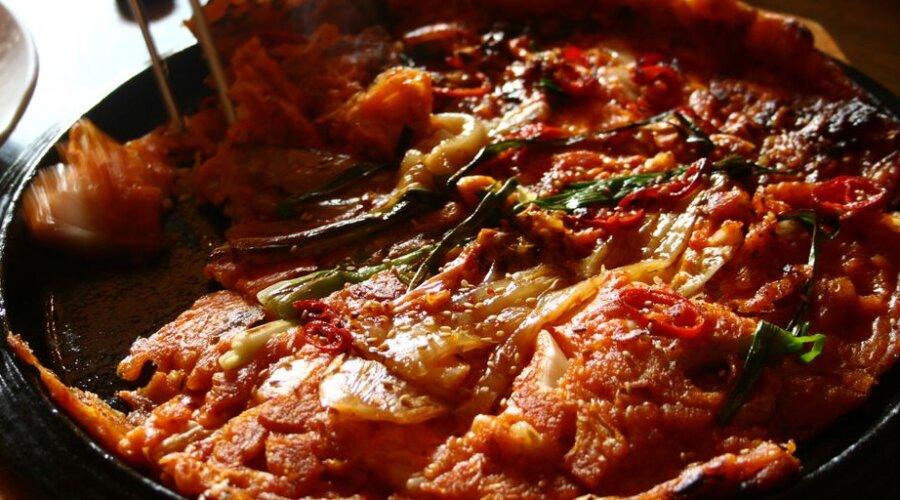“Street Food Sensations: Indulging in South Korea’s Tastiest Treats”
One of the highlights of South Korean cuisine is its vibrant street food culture. In the bustling markets and narrow alleys of Seoul, you’ll find a multitude of stalls and carts offering an array of delectable snacks and quick bites. From the iconic tteokbokki, featuring chewy rice cakes bathed in a spicy sauce, to the crispy and savory pajeon scallion pancakes, these street food delights capture the energy and spirit of South Korean culinary traditions. This cookbook will guide you through the art of recreating these street food favorites in your own kitchen, allowing you to experience the excitement and flavors of South Korea’s bustling street food scene wherever you are.
Key Takeaways
- South Korea’s street food culture is vibrant and diverse, offering a variety of snacks and quick bites.
- Iconic dishes like tteokbokki and pajeon capture the essence of South Korean culinary traditions.
- The cookbook provides guidance on recreating these street food favorites at home.
- Exploring regional specialties offers a deeper understanding of South Korea’s rich culinary landscape.
- Dining experiences in South Korea are about more than just food; they immerse you in the country’s culinary traditions.
Sizzling Delights: Tteokbokki and Beyond

The Iconic Tteokbokki
Tteokbokki is one of the most popular Korean street dishes, known for its chewy rice cakes bathed in a spicy and somewhat sweet sauce. This dish perfectly captures the spirit of South Korean street food culture, offering a delightful tactile contrast with its crunchy outside and mushy rice cake middle. If you’ve ever wandered through the bustling markets of Seoul, like Namdaemun or Dongdaemun, you’ve likely encountered this iconic treat.
Variations to Try
While the classic tteokbokki is a must-try, there are several variations that you shouldn’t miss:
- Cheese Tteokbokki: A creamy twist with melted cheese on top.
- Seafood Tteokbokki: Packed with fresh seafood like shrimp and squid.
- Rose Tteokbokki: A milder version with a creamy, rose-colored sauce.
These variations offer a new way to enjoy the beloved dish, each bringing its own unique flavor profile to the table.
Cooking Tips
Making tteokbokki at home is easier than you might think! Here are some tips to get you started:
- Use fresh rice cakes: Fresh rice cakes are softer and cook more evenly.
- Balance the flavors: Adjust the spiciness and sweetness to your liking.
- Add ingredients gradually: This ensures everything cooks evenly and absorbs the sauce well.
Embrace the strong and dynamic flavors of tteokbokki, and you’ll find yourself transported to the vibrant street food scenes of South Korea.
Crispy and Savory: Korean Pancakes

Korean pancakes, or jeon, are a must-try when exploring South Korea’s street food scene. These savory delights are perfect for any time of the day and come in various forms, each offering a unique taste experience. Let’s dive into some of the most popular types and how you can make them at home.
Pajeon: The Classic Scallion Pancake
Pajeon is a beloved Korean pancake made primarily with scallions. The batter, which includes all-purpose flour, water, and eggs, is mixed with a generous amount of scallions to create a crispy and flavorful dish. It’s a staple in many Korean households and cafe-restaurants.
Haemul Pajeon: Seafood Twist
For seafood lovers, Haemul Pajeon is a must-try. This variation includes a mix of seafood like shrimp, squid, and clams, adding a delightful twist to the classic scallion pancake. The seafood is mixed into the batter, ensuring every bite is packed with flavor.
Making Perfect Pajeon at Home
Creating the perfect Pajeon at home is easier than you might think. Here are some tips to get you started:
- Consistency of the batter: Ensure your batter is not too thick or too runny. It should coat the back of a spoon smoothly.
- Use a non-stick pan: This helps in achieving that perfect crispy texture without sticking.
- Cook on medium heat: This ensures the pancake cooks evenly without burning.
With these tips, you’ll be making delicious Pajeon in no time, impressing your friends and family with your Korean culinary skills!
Sweet Endings: Korean Desserts

And no journey through South Korean cuisine would be complete without a sweet ending. Delight your taste buds with irresistible desserts like bingsu, hotteok, and yakgwa, indulging in the enchanting world of Korean sweets.
Street Food Adventures in Seoul

One of the highlights of South Korean cuisine is its vibrant street food culture. In the bustling markets and narrow alleys of Seoul, you’ll find a multitude of stalls and carts offering an array of delectable snacks and quick bites. From the iconic tteokbokki, featuring chewy rice cakes bathed in a spicy sauce, to the crispy and savory pajeon scallion pancakes, these street food delights capture the energy and spirit of South Korean culinary traditions.
Must-Visit Markets
Gwangjang Market is a must-visit for any food lover. This market is one of the oldest and largest in Seoul, offering everything from fresh produce to traditional Korean street food. Don’t miss out on trying bindaetteok (mung bean pancakes) and mayak gimbap (mini seaweed rice rolls).
Hidden Gems
While the big markets are fantastic, some of the best street food can be found in the narrow alleys and less touristy areas. Places like Tongin Market offer a more local experience where you can try unique dishes like tteokgalbi (grilled short rib patties).
Street Food Etiquette
When indulging in street food, it’s important to follow some basic etiquette. Always pay attention to the line and wait your turn. It’s also polite to eat near the stall where you bought your food, as this helps keep the area clean and organized.
Exploring Seoul’s street food scene is not just about eating; it’s about experiencing the vibrant culture and energy of the city. From the sizzling street food stalls of Seoul to the tranquil countryside villages, this book unravels the secrets of South Korean cooking, revealing cherished recipes passed down through generations.
Regional Specialties: A Culinary Tour

Embark on a culinary journey through South Korea’s diverse regions, each offering unique flavors and dishes that reflect their local culture and traditions. From the sizzling street food stalls of Seoul to the tranquil countryside villages, there’s something for everyone to enjoy.
Busan’s Seafood Treasures
Busan, a bustling port city, is renowned for its fresh seafood. The Jagalchi Fish Market is a must-visit, where you can sample everything from raw fish to grilled shellfish. Don’t miss out on the spicy fish stew, Maeuntang, which is a local favorite.
Jeonju’s Fiery Delicacies
Jeonju is famous for its bold and spicy dishes. The city’s signature dish, Bibimbap, is a colorful mix of rice, vegetables, and gochujang (red chili paste). For those who love a bit of heat, Jeonju’s fiery delicacies are sure to satisfy your taste buds.
Jeju Island’s Unique Flavors
Jeju Island offers a unique culinary experience with its use of fresh, local ingredients. From the famous black pork to the refreshing Hallabong oranges, the island’s cuisine is a delightful blend of flavors. Be sure to try the seafood hot pot, Haemultang, which is a true representation of Jeju’s bountiful marine life.
Whether you’re a seasoned chef or an enthusiastic home cook, this culinary tour will transport you to the bustling streets and serene landscapes of South Korea. Unleash your creativity, savor the bold flavors, and embark on a flavorful journey that will leave you longing for more.
Korean Snacks: A Fusion of Flavors

Korea has long been celebrated for its rich culinary culture, and its snack scene is no exception. Korean snacks offer a delightful fusion of flavors, textures, and innovative culinary techniques that captivate snack enthusiasts worldwide. From the fiery heat of spicy tteokbokki to the comforting sweetness of chocolate-covered cakes, Korean snacks present a diverse selection of tastes and experiences. In this blog, we will dig into the dynamic world of Korean snack trends, exploring the latest sensations from spicy to sweet that are captivating taste buds across the globe.
Dining Experiences: More Than Just Food

Dining at prominent South Korean restaurants is about more than simply the cuisine; it’s about immersing oneself in the country’s rich culinary traditions. Whether you’re sampling street cuisine at Gwangjang Market, eating a substantial bowl of noodle soup at Myeongdong Kyoja, or indulging in delicious barbecue at Palsaik Namu, each dining experience offers a narrative about South Korea’s culinary past.
Conclusion
From the bustling streets of Seoul to the tranquil shores of Jeju Island, South Korea’s street food scene is a vibrant tapestry of flavors, textures, and aromas. These food delights capture the energy and spirit of South Korean culinary traditions, offering a sensory adventure that’s hard to resist. Whether you’re indulging in spicy tteokbokki or savoring a sweet hotteok, each bite is a testament to the country’s rich culinary heritage. With this guide, you can bring a piece of that excitement into your own kitchen, recreating these street food favorites and experiencing the thrill of South Korea’s bustling markets wherever you are. So, grab your apron and get ready to embark on a delicious journey through the heart of South Korean street food!
Frequently Asked Questions
What is Tteokbokki?
Tteokbokki is a popular South Korean street food made from chewy rice cakes cooked in a spicy and sweet red chili sauce.
Where can I find the best street food in Seoul?
Some of the best places to find street food in Seoul are Gwangjang Market, Myeongdong, and Namdaemun Market.
What are some must-try Korean desserts?
Must-try Korean desserts include Bingsu (shaved ice delight), Hotteok (sweet pancakes), and Yakgwa (honey cookies).
How do I make Pajeon at home?
To make Pajeon at home, you need flour, water, eggs, scallions, and your choice of seafood or vegetables. Mix the ingredients into a batter and fry until crispy and golden brown.
What are some regional specialties in South Korea?
Regional specialties in South Korea include Busan’s seafood treasures, Jeonju’s fiery delicacies, and Jeju Island’s unique flavors.
What is the etiquette for eating street food in South Korea?
When eating street food in South Korea, it’s polite to stand near the vendor’s stall, dispose of trash properly, and be mindful of other customers waiting to order.



